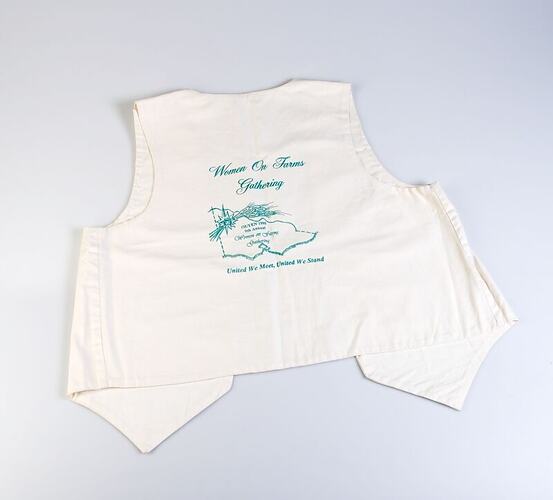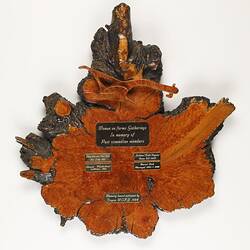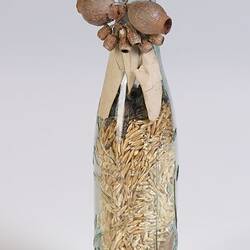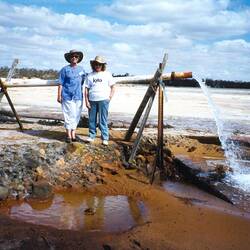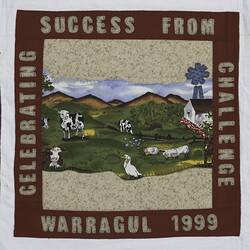Summary
Calico vest worn by members of the 1998 Ouyen Women on Farms Gathering organising committee. During the weekend all members of the committee wore this vest so that they could be easily recognisable to Gathering attendees.
Part of Museums Victoria's Invisible Farmer Project Collection. The Invisible Farmer Project was the largest ever study of Australian women on the land, uncovering the histories and stories of Australian women in agriculture. It began as a pilot project (2015-2016) and evolved into a three year (2017-2020) nation-wide partnership between rural communities, academic, government and cultural organisations, funded by the Australian Research Council.the absence of rural women in mainstream histories and museums.
Physical Description
Cream calico vest with green printing on the back that includes text and an image. Text reads 'Women on Farms Gathering' above the image and 'United We Meet, United We Stand' below the image. The central image depicts the State of Victoria with a bunch of wheat on the upper left corner marking out the location of Ouyen. Text reads 'OUYEN 1998/9th Annual/Women on Farms./Gathering'.
Significance
This object was collected by a member of the organising committee for the 1998 Ouyen Gathering. It represents and celebrates the voluntary work of those women who worked on the committee to bring about the Gathering. A key feature that unites all Victorian Women on Farms Gatherings is the voluntary nature of these events. Women from the local region usually come together approximately one to two years prior to the Gathering to begin planning and organising, which includes securing a venue, sponsorship, accommodation, catering, publicity, tours, workshops and speakers. During the event the organising committee continue to oversee and run the Gathering, and it is customary for them to wear something that will make them identifiable to Gathering participants. Objects such as this calico vest represent the voluntary contribution that these women have made not only to the Gatherings themselves, but also to their local communities and to the wider rural women's movement in Australia.
More Information
-
Collection Names
-
Collecting Areas
Sustainable Futures, Working Life & Trades, Clothing & Textiles
-
Acquisition Information
Donation from Teresa Scott - Ouyen Women on Farms Gathering, 29 Mar 2003
-
Creator
Victorian Women on Farms Gathering, Ouyen, Mallee, Victoria, Australia, 1998
-
User
Teresa Scott - Ouyen Women on Farms Gathering, Ouyen, Mallee, Victoria, Australia, 1998
-
Place & Date of Event
-
Inscriptions
Text: Women on Farms/Gathering/OUYEN 1998/9th Annual/Women on Farms/Gathering/United We Meet, United We Stand.
-
Classification
Agriculture & rural life, Community activity - women on farms gathering, Clothing
-
Category
-
Discipline
-
Type of item
-
Keywords
Agriculture, Gender Issues, Globalisation, Politics, Rural Life, Work, Women on Farms Gatherings
